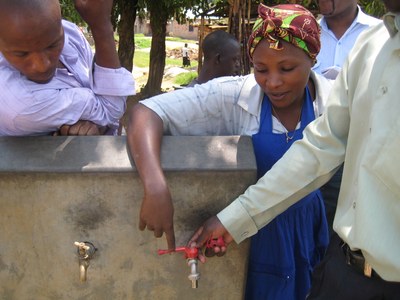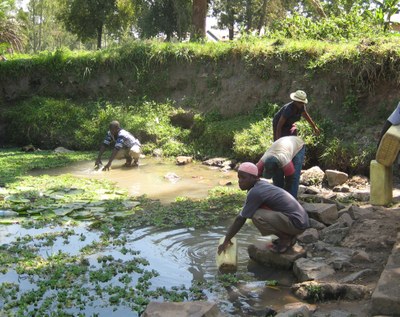Water vendors versus women water users
One Sunday afternoon, Pauline is attending her shop set out on a wooden rack. She sells fruits, vegetables, dried fish, batteries, charcoal and everything else a normal household in this small town in Western Uganda would need daily. A few metres away, a water standpost can be seen, with three taps and a platform looking suspiciously dry. For the past eight months she has been the official water tap operator selling the water and keeping accounts. She sells the water from the standpost at Ush 100 (4.6 US dollar cents) per jerry can of 20 litres. The main tap at the back, where the water meter is visible, is broken. Pauline says that it is of poor quality, and that most of the other taps have this same problem. Taps at the front have already been replaced five times. She is now waiting for the plumber who is at the same time her contact person and tenderer at the Town Hall.
 |
|---|
| Pauline shows the new water tap, after it was replaced |
Broken standposts and water vendors
With this water standpost and the other five in town not working, most people without a home connection depend once again on the water vendors, young men who fill their jerry cans in an open waterhole at the low end of the town. They walk from stone to stone to sit on one in the middle of the water hole, to get the relatively clear but untreated water and fill six jerry cans at once. They tie them on their rickety bicycles and cycle up, which is quite heavy work. The vendors bring the water to the doorsteps and charge Ush 200 (9.1 US dollar cents) for 20 litres.
In the town it is often said that the taps are vandalised at night. The Multi Stakeholders Forum, organised for the UN-Habitat’s programme Lake Victoria Water and Sanitation Initiative (LVWATSAN), also mentions the continuous vandalising of the taps, which renders this new form of water supply meant for poor people rather ineffective. The water vendors are mentioned as the culprits who break the taps, so as not to lose their customers. Pauline does not directly accuse the water vendors of vandalising the tap stands; she is not there at nights to see it happen.
The Gender and Water Alliance (GWA) takes part in the interdisciplinary inquiries in the town, and some of the stakeholder categories are asked to tell their stories and issues.
The view from the waterhole
The next day the inquiry team walks to the waterhole and finds some water vendors there, filling their jerry cans and fixing their cycles, some more come racing down the slope, to come to a squeaking halt with obviously bad brakes. One of them specialises as the cycle repairer.
Their point of view throws a different light on the situation. Each vendor has to pay the town council for a licence, a daily fee for the cycles and a fee for the cans to a person called the tenderer. They work hard and people prefer their water to that from the taps. Their water tastes better, uses less detergent when washing, and does not leave a coloured film after boiling. Still, they are not respected; on the contrary, they are despised in the town. Whenever there is an accident, not unthinkable seeing how they race down the road, they are always blamed, and never the other person. There have been some problems with harassment of women, but now the vendors say they have rules and one, called the defence vendor, keeps order within the group. They have no other opportunities of making a living, and are not very happy with the new water infrastructure brought by the UN-Habitat programme, such as the water standposts. When asked what they think about the vandalising of the taps, they all laugh. One says, “even though the system is highly protected we are all interested in it breaking down.” They have not been asked to perform as tap operators, and would like to have such a job.
 |
|---|
| Water vendors collecting water at the waterhole |
We had difficulty in finding women water users to ask their opinion, firstly because they all are very busy, and secondly because many do not feel secure enough to get water at the waterhole themselves. All the stones are occupied by young men, talking their young men talk, embarrassing the women, and even touching them and hitting them jokingly with their cans. The vendors may be proud of their rules but women see this differently. In the end even women who are poor and would prefer to carry the water themselves decide to buy the water from the vendors whenever they can, to avoid the harassment.
This is the context in which the partners of the LVWATSAN Capacity Building programme do their inquiries to develop a tailor made training and capacity building plan for each of the ten towns of the programme. Issues of different stakeholders are collected, which happen to be surprisingly different in each of the towns.
Different methods of analysis
This situation in a town in Uganda is interesting to analyse from two perspectives. From a Women-In-Development perspective (WID), looking at the town and these stakeholders, the position of the women water users deteriorated because first they could get water themselves from that water hole for free, carrying it uphill themselves, whilst now they have to pay for it, and quite a lot. The water from the taps is cheaper, but apparently also not safe, and most of the time not available. Even the women tap operators hardly benefit, since the taps keep breaking. A WID solution could be to suggest that the water hole is forbidden territory for the male vendors during some fixed times. However, the use of unsafe water would continue.
The second option is to analyse the situation from a Gender and Empowerment perspective. This understands that the interests of the vendors also need to be taken into account alongside those of women water users. These boys would prefer any other job, particularly an empowering work that would give them respect in the town instead of contempt. If they had other occupations they would stop vandalising the taps, and women could get low cost water from nearby standposts. Empowerment of the women would also result in them not being stopped by a group of young men at the water hole. They would go there together and make a point of getting their rights. Pauline and other tap operators would be able to make a living of this occupation if the taps have pressure all the time.
GWA contributes a Gender and Empowerment perspective to the wealth of experience gathered on local governance, on gender relations at the grass roots and on environmental and technical aspects, in the LVWATSAN programme, forming the foundation for an appropriate applied pro-poor capacity building programme.


